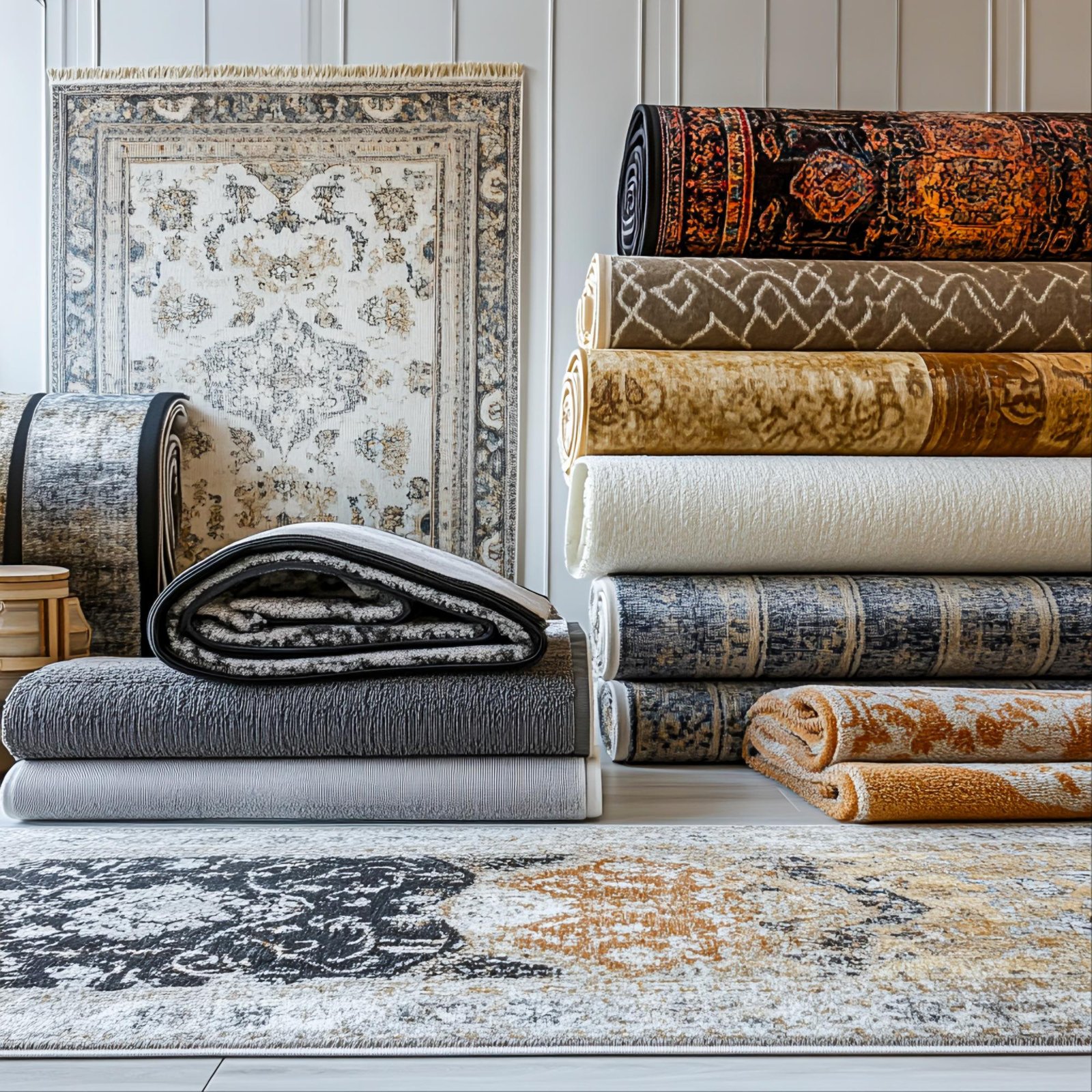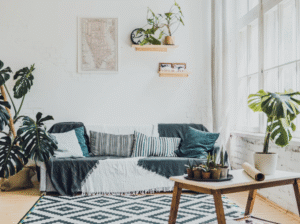A beautiful handmade rug can completely transform a room, tying together furniture, adding warmth, and expressing your personal style. But as demand for these artisanal pieces grows, so does the confusion around the different types available. With terms like hand-knotted, hand-tufted, and flatweave being used, it’s easy to feel overwhelmed. How do you know which one is right for your home, your budget, and your lifestyle?
Understanding how a rug is made is the key to making a confident purchase. The construction technique affects everything from its durability and texture to its price and design intricacy. This guide will walk you through the primary differences between hand-knotted, hand-tufted, and flatweave rugs, giving you the knowledge to choose a piece you’ll love for years to come.
Whether you’re decorating your first apartment or searching for an heirloom-quality piece for your forever home, this post will clarify the unique characteristics of each rug type. We will compare their construction, longevity, feel, and cost, so you can find the perfect handmade rug that truly completes your space.
An Overview of the Three Main Rug Types
Before we explore the details, let’s start with a quick introduction to the three main types of handmade rugs. While they all begin with skilled artisans, their creation methods are vastly different.
- Hand-knotted rugs are the most traditional and labor-intensive. Artisans tie individual knots onto a loom, creating a dense, durable pile. These are considered works of art and are built to last for generations.
- Hand-tufted rugs are made using a handheld tool called a tufting gun, which punches yarn through a canvas backing. This method is much faster than hand-knotting, making these rugs more affordable while still offering a plush feel.
- Flatweave rugs are woven on a loom without any knots, resulting in a thin, lightweight rug with no pile. This category includes popular styles like dhurries and kilims, known for their geometric patterns and casual appeal.
Understanding the core differences in this hand-knotted vs. hand-tufted vs. flatweave comparison is the first step toward finding your ideal rug.
What Are Hand-Knotted Rugs?
Hand-knotted rugs are the pinnacle of rug-making, celebrated for their extraordinary craftsmanship, durability, and timeless beauty. Each rug is a one-of-a-kind masterpiece, reflecting centuries of tradition passed down through generations of artisans. These are not just floor coverings; they are investments in art and history.
How Hand-Knotted Rugs Are Made
The process of creating a hand-knotted rug is incredibly meticulous and time-consuming. It begins with a specialized loom, where a foundation of vertical threads (warp) is stretched tightly. Skilled weavers then tie individual knots of wool or silk around these warp threads, one by one, to form the rug’s pile. After each row of knots is complete, a horizontal thread (weft) is passed through to secure it. This knot-by-knot technique can take months, or even years, to complete for a single rug, depending on its size and the complexity of the design.
Characteristics
The defining features of hand-knotted rugs stem from their unique construction.
- Exceptional Durability: The tightly packed knots create an incredibly strong and resilient structure. A well-maintained hand-knotted rug can last for decades, often becoming a cherished family heirloom.
- Unique, Intricate Patterns: Because they are made by hand, no two hand-knotted rugs are ever exactly alike. You’ll notice slight variations in the pattern and color, which are considered part of their charm and authenticity. The fringe on these rugs is an integral part of the warp threads, not an added embellishment.
- Premium Quality: The combination of high-quality materials (like silk and wool), skilled craftsmanship, and the sheer time involved in their creation places hand-knotted rugs in a class of their own.
Pros and Cons
Pros:
- Longevity: Built to last for generations.
- Artisanal Craftsmanship: Each rug is a unique work of art.
- Heirloom-Quality: They often appreciate in value over time.
- Exceptional Feel: The dense pile offers a luxurious and comfortable texture underfoot.
Cons:
- Expensive: The high level of skill and time required makes them the most costly rug type.
- Long Production Time: A custom rug can take many months to weave.
Best Use Cases
Given their value and durability, hand-knotted rug features make them ideal for spaces where you want to make a statement. They are perfect for formal living rooms, elegant dining rooms, and luxury master bedrooms. Collectors also prize them for their artistic and investment value.
What Are Hand-Tufted Rugs?
Hand-tufted rugs offer a wonderful balance of style, comfort, and affordability. They provide the look and feel of a high-end plush rug but are produced much more quickly than their hand-knotted counterparts, making them a popular choice for modern homes.
How Hand-Tufted Rugs Are Made
Instead of being tied by hand, hand-tufted rugs are made with a mechanized tool called a “tufting gun.” An artisan stretches a canvas backing onto a frame and then uses the gun to punch loops of yarn through it, following a pre-drawn design. This process is significantly faster than hand-knotting. Once the tufting is complete, a layer of latex adhesive is applied to the back to hold the yarns in place. Finally, a protective backing cloth is attached to cover the latex. The loops on the front can either be left as is for a looped texture or sheared to create a cut pile.
Characteristics
Hand-tufted rugs are easily identifiable by their construction.
- Glued-On Backing: The most telling feature is the fabric backing, which is necessary to secure the tufts. In contrast, the back of a hand-knotted rug shows the individual knots of the design.
- Faster Production: Because of the tufting gun, these rugs can be made in a fraction of the time it takes to weave a hand-knotted one.
- Wide Design Variety: This method allows for a great deal of design flexibility, from simple geometrics to complex floral patterns.
Pros and Cons
Pros:
- Affordable: A more budget-friendly alternative to hand-knotted rugs.
- Stylish and Plush: They offer a soft, luxurious feel underfoot.
- Quicker Manufacturing: Readily available in a wide range of designs and colors.
Cons:
- Shorter Lifespan: The latex backing can degrade over time, typically lasting 5–10 years.
- Prone to Shedding: It’s common for new hand-tufted rugs to shed loose fibers, though this usually subsides with regular vacuuming.
Best Use Cases
The hand-tufted rug benefits make them excellent for spaces that receive low to medium foot traffic. They are a great fit for bedrooms, cozy living rooms, and home offices where you want a soft, stylish rug without the premium price tag of a hand-knotted piece.
What Are Flatweave Rugs?
Flatweave rugs are known for their lightweight, versatile, and often reversible nature. Lacking a pile, these rugs are woven on a loom, creating a thin, flat surface. This category includes well-known styles like dhurries, kilims, and soumaks, each with its own regional weaving traditions.
How Flatweave Rugs Are Made
Like hand-knotted rugs, flatweaves are created on a loom. However, instead of tying knots, the weaver interlaces vertical (warp) and horizontal (weft) threads to create the entire fabric of the rug, including the pattern. Since there is no pile or backing, the pattern is visible on both sides, making many flatweaves reversible. This simple yet durable weaving technique results in a rug that is both light and tough.
Characteristics
Flatweave rug features are distinct and practical.
- No Pile: Their flat surface makes them easy to move, layer, and clean.
- Lightweight and Reversible: Many flatweaves can be flipped over, effectively doubling their lifespan.
- Easy to Clean: Spills tend to sit on the surface rather than soaking into a deep pile, making them easier to blot up. Regular vacuuming keeps them looking fresh.
Pros and Cons
Pros:
- Affordable: Generally the most budget-friendly of the handmade rug types.
- Low Maintenance: Their construction makes them simple to care for.
- Versatile: Their casual aesthetic and durability work well in a variety of settings.
Cons:
- Less Plush: They do not offer the cushioned feel of a pile rug.
- May Slip: A rug pad is highly recommended to keep them from sliding and to add a layer of cushioning.
Best Use Cases
Flatweaves are workhorses. Their durability and ease of maintenance make them perfect for high-traffic areas like hallways, kitchens, and dining rooms (it’s easy to slide chairs over their flat surface). They are also a fantastic choice for casual living spaces, apartments, and children’s rooms.
Hand-Knotted vs. Hand-Tufted vs. Flatweave: Key Differences
| Feature | Hand-Knotted | Hand-Tufted | Flatweave |
|---|---|---|---|
| Construction | Knots individually tied by hand to form design | Yarn punched into a canvas using tufting gun, then glued backing | Woven by interlacing warp and weft, no knots or pile |
| Appearance | Intricate, highly detailed patterns; visible knots on back | Plush, soft pile with smooth backing; design traced, not knotted | Flat surface, thin and lightweight, no pile; design often geometric or tribal |
| Durability | Extremely durable, can last decades or centuries | Good for medium use, typically lasts 5-10 years | Least durable, best for low-traffic areas; easier to maintain |
| Price Point | Highest, labor-intensive and considered investment pieces | Moderate, faster and less costly production | Lowest, budget-friendly option |
| Typical Materials | Wool, silk, or cotton; luxurious feel | Wool, cotton, synthetic blends | Wool, cotton, or other natural fibers |
| Maintenance | Professional cleaning recommended | Can be cleaned at home, but may shed or wear | Easy to clean, often reversible |
| Reversibility | Not reversible; knots visible on back | Not reversible; usually a cloth backing | Reversible; identical on both sides |
| Ideal Use | High-traffic areas, statement pieces | Bedrooms, offices, medium traffic | Dining area, hallway, casual spaces |
Now that you understand each rug type, let’s put them side-by-side for a clear rug types comparison.
Construction Techniques
- Hand-Knotted: Individual knots are tied by hand onto a loom’s foundation. This requires immense skill and time.
- Hand-Tufted: A tufting gun punches yarn through a canvas backing, which is then secured with latex adhesive.
- Flatweave: Yarns are woven together on a loom to create a flat textile with no pile.
Durability and Lifespan
- Hand-Knotted: The gold standard, lasting for decades or even centuries.
- Hand-Tufted: A shorter lifespan of 5–10 years, as the latex backing can degrade.
- Flatweave: Durability varies by material but is generally very good, especially since they are often reversible.
Texture and Feel
- Hand-Knotted: Dense, plush, and luxurious underfoot.
- Hand-Tufted: Soft and semi-plush, offering a comfortable feel.
- Flatweave: Flat and thin, with a more textured feel and no cushioning.
Price Comparison
- Hand-Knotted: The most expensive (premium).
- Hand-Tufted: A mid-range option.
- Flatweave: The most budget-friendly choice.
Design Variety
- Hand-Knotted: Known for intricate, traditional, and heirloom-quality patterns.
- Hand-Tufted: Offers the most design freedom, from modern abstracts to classic motifs.
- Flatweave: Often features geometric, tribal, and ethnic styles.
How to Choose the Right Rug Type: A Buying Guide
Choosing between hand-knotted vs. hand-tufted or tufted vs. flatweave depends entirely on your specific needs. Here’s how to decide:
- Consider Your Budget: Your budget is the most straightforward starting point. If you’re looking for an affordable, stylish option, start with flatweaves and hand-tufted rugs. If you’re investing in a forever piece, a hand-knotted rug is worth considering.
- Think About Usage: Where will the rug go? For high-traffic areas like entryways and hallways, a durable flatweave is an excellent choice. For a cozy bedroom or a formal living room, the plushness of a hand-knotted or hand-tufted rug might be more appealing.
- Define Your Design Preference: Are you looking for a complex, intricate pattern that tells a story? A hand-knotted rug is your best bet. Do you want a bold, modern design? Look at hand-tufted options. If you love geometric or bohemian styles, explore flatweaves.
- Factor in Maintenance: Do you have kids or pets? A low-maintenance, easy-to-clean flatweave might be the most practical choice. While all handmade rugs require care, the pile-less nature of a flatweave makes it less likely to trap dirt and allergens.
Where to Buy Premium Rugs in India
When you’re ready to invest in a high-quality handmade rug, you need a trusted source that values craftsmanship and design.
The Ambiente: India’s Top Destination for High-Quality Rugs
At The Ambiente, we believe a rug has the power to define the atmosphere of your home. Rooted in Bhadohi, India’s heartland of carpet weaving, our brand combines 30 years of expertise with a fresh, design-led approach. We offer an exquisite collection of hand-knotted, hand-tufted, and flatweave rugs, available both ready-to-ship and as custom designs. Whether you need a statement piece for your living room or a durable runner for your hallway, our artisan-made rugs bring elegance and authenticity to modern Indian homes.
Why Choose The Ambiente?
- Exceptional Craftsmanship: We work with a collective of over 4,000 artisans—many of whom are women—to create rugs of unparalleled quality.
- Sustainable and Ethical: We are committed to empowering our local weavers by providing a sustainable livelihood and a platform for their incredible skills.
- Designer-Approved Collections: Our in-house design team collaborates with our artisans to produce rugs that are timeless, trendy, and unique.
- Pan-India Delivery: Explore our collections online and have your perfect rug delivered right to your doorstep, anywhere in India.
Frequently Asked Questions
How do I identify a real hand-knotted rug?
Turn it over. The back of a hand-knotted rug will mirror the design on the front, and you’ll be able to see the individual knots. The fringe will also be part of the rug’s core structure, not sewn on.
Are hand-tufted rugs durable?
Hand-tufted rugs are durable enough for everyday use in low- to medium-traffic areas. Their lifespan is typically 5–10 years, limited by the longevity of the latex backing rather than the yarn itself.
Is a flatweave rug good for Indian homes?
Absolutely. Flatweaves are perfect for the Indian climate as they are lightweight and don’t trap heat. Their durability and ease of cleaning also make them a practical and stylish choice for busy households.
Which rug type is the easiest to clean?
Flatweave rugs are generally the easiest to clean due to their lack of pile. Spills can be blotted up quickly, and they can be shaken out to remove dust and debris.
Find Your Perfect Rug Today
Choosing a handmade rug is a personal journey. By understanding the differences between hand-knotted, hand-tufted, and flatweave rugs, you can confidently select a piece that aligns with your budget, lifestyle, and aesthetic. Each type offers a unique blend of artistry and function, ready to add warmth and character to your home.
Ready to find the perfect foundation for your space? Explore the premium collections of hand-knotted, hand-tufted, and flatweave rugs at The Ambiente today. If you need guidance, schedule a consultation with our design experts to discover a rug that’s just right for you.





